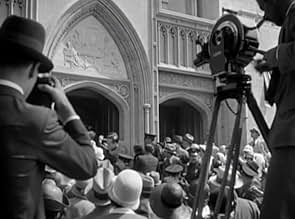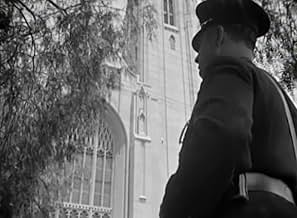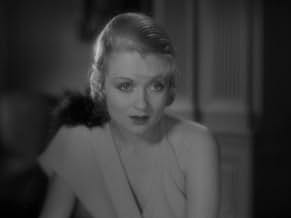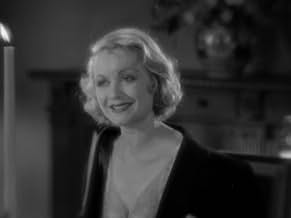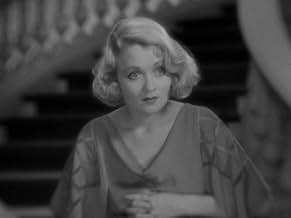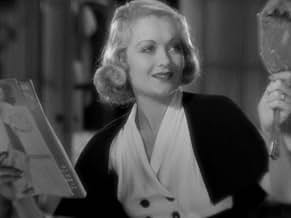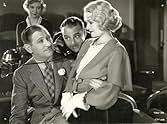AVALIAÇÃO DA IMDb
7,0/10
2,9 mil
SUA AVALIAÇÃO
Adicionar um enredo no seu idiomaThe career of a waitress takes off when she meets an amiable drunken Hollywood director.The career of a waitress takes off when she meets an amiable drunken Hollywood director.The career of a waitress takes off when she meets an amiable drunken Hollywood director.
- Direção
- Roteiristas
- Artistas
- Indicado a 1 Oscar
- 3 vitórias e 1 indicação no total
George Reed
- Undetermined Secondary Role
- (cenas deletadas)
Alice Adair
- Undetermined Secondary Role
- (não creditado)
Eddie 'Rochester' Anderson
- James - Max's Butler
- (não creditado)
Sam Armstrong
- Undetermined Secondary Role
- (não creditado)
Zeena Baer
- Secretary to Julius Saxe
- (não creditado)
King Baggot
- Department Head
- (não creditado)
Gerald Barry
- John Reed - an Actor
- (não creditado)
Floyd Bell
- Undetermined Secondary Role
- (não creditado)
Veda Buckland
- Nana - Jackie's Nursemaid
- (não creditado)
Nicholas Caruso
- Chef at Brown Derby
- (não creditado)
Lita Chevret
- Actress Filming on Movie Set
- (não creditado)
Avaliações em destaque
This early effort by director George Cukor had such resonance that it was remade three times as A STAR IS BORN, so it lives on to satisfy the curiosity of those who admire one or more of the later productions. What holds it up after all these years are a strong and realistic performance by Lowell Sherman as a successful Hollywood film director whose alcoholism is destroying his career, decent and sometimes brilliant work by ever-stylish Constance Bennett as the ambitious waitress who becomes an overnight star, beautiful and poetic montages by Slavko Vorkapich, a generally witty and clever script by a team of about eight writers including Adela Rogers St. John and Gene Fowler, and some beautifully directed intimate scenes including the opening in which Bennett dresses for work, copying the beauty tips advertised in the fan magazine she is reading. Highlights: the screen test in which Bennett repeatedly fails to gracefully descend a staircase, deliver one line and then react to the sight of a dead body outside camera range; the filming of a nightclub scene in which Bennett delivers a love song in French (a la Dietrich in MOROCCO) as she strolls among the seated patrons. When you think about it, Bennett is really too sophisticated and worldly for this part, which is why it worked much better for the homespun Janet Gaynor five years later. It really doesn't make sense that a lady who can handle herself with complete ease after being dragged to a movie premiere and unexpectedly shoved in front of a microphone would suddenly turn into a klutz in front of a movie camera in a studio screen test. At one point Bennett is seen to converse in flawless, fluent French and we can only wonder how a lowly waitress with naïve dreams of movie stardom ever got that kind of linguistic education. The only explanation could be that the casting of Bennett required compromises. In any case, her natural charm carries her through.
At times the story drags. Neil Hamilton as the stuffed shirt husband adds to the dead weight. The sound quality in the outdoor scenes is weak and tinny. Gregory Ratoff as a studio chieftain has fun but his accent is a bit too thick given the limitations of the recording techniques of the time. Louise Beavers, as always, enlivens her small role as Bennett's maid.
At times the story drags. Neil Hamilton as the stuffed shirt husband adds to the dead weight. The sound quality in the outdoor scenes is weak and tinny. Gregory Ratoff as a studio chieftain has fun but his accent is a bit too thick given the limitations of the recording techniques of the time. Louise Beavers, as always, enlivens her small role as Bennett's maid.
One of George Cukor's earliest successes before his glory years at MGM was this classic What Price Hollywood. Done at RKO it's the story of three star crossed people and that's literal for one of them.
Constance Bennett plays Mary Evans who is discovered by drunken director Lowell Sherman while working as a waitress at the famous Brown Derby in Hollywood. In 1932 that was the place to be if one wanted to be discovered because all the Hollywood celebrities dined there at one time or another. Including those like Sherman who liked their cuisine strictly liquid and at that time illegal.
You might think that playing a movie star was no stretch for Connie Bennett. But she and her sisters Joan and Barbara were of a distinguished theatrical family with father Richard Bennett in Hollywood himself at that time. She was as far removed from Mary Evans in real life as you can get, still Bennett got deep inside the part.
Sherman might have modeled his character on any number of distinguished Hollywood lushes. He probably took bits from all of them, but his director is uniquely his own, at once self centered, talented, vain and frail.
The third part of this triangle is Neil Hamilton, polo playing scion of a prominent society family who is introduced to Bennett when he smacks her with a polo ball. It was definitely love at first sight, but love between them takes a rocky road.
Hollywood has never been easy on itself. The movie industry figures that the scandals they've had are all too public so honesty is probably the best policy. In the sound era What Price Hollywood is one of the first of a long line of critical examination of the movie industry that also includes The Big Knife, The Bad And The Beautiful, Callaway Went Thataway and Two Weeks In Another Town. And of course we can't forget A Star Is Born in its original and remakes.
What Price Hollywood got an Oscar nomination for Best Original Screenplay. As its done before the Code, it holds up well today as a mark of distinguished and mature film making.
Constance Bennett plays Mary Evans who is discovered by drunken director Lowell Sherman while working as a waitress at the famous Brown Derby in Hollywood. In 1932 that was the place to be if one wanted to be discovered because all the Hollywood celebrities dined there at one time or another. Including those like Sherman who liked their cuisine strictly liquid and at that time illegal.
You might think that playing a movie star was no stretch for Connie Bennett. But she and her sisters Joan and Barbara were of a distinguished theatrical family with father Richard Bennett in Hollywood himself at that time. She was as far removed from Mary Evans in real life as you can get, still Bennett got deep inside the part.
Sherman might have modeled his character on any number of distinguished Hollywood lushes. He probably took bits from all of them, but his director is uniquely his own, at once self centered, talented, vain and frail.
The third part of this triangle is Neil Hamilton, polo playing scion of a prominent society family who is introduced to Bennett when he smacks her with a polo ball. It was definitely love at first sight, but love between them takes a rocky road.
Hollywood has never been easy on itself. The movie industry figures that the scandals they've had are all too public so honesty is probably the best policy. In the sound era What Price Hollywood is one of the first of a long line of critical examination of the movie industry that also includes The Big Knife, The Bad And The Beautiful, Callaway Went Thataway and Two Weeks In Another Town. And of course we can't forget A Star Is Born in its original and remakes.
What Price Hollywood got an Oscar nomination for Best Original Screenplay. As its done before the Code, it holds up well today as a mark of distinguished and mature film making.
What that lady needed was a good script and a fine director. She had both in "Our Betters." And she had it here. And this one will break your heart.
The on-the-set ambiance is very plausible. Lowell Sherman is excellent as the tippling director who discovers waitress Bennett and becomes a heavier drinker. Gregory Ratoff is superb as the initially brusque but increasingly sympathetic producer Saxe.
Conusance Bennett is likable as the ambitious waitress. She gets us to smile as she starts out as a crummy actress but works hard at it. And she is directed to a superb performance when things for Sherman, her, and her husband Neil Hamilton get tough.
The on-the-set ambiance is very plausible. Lowell Sherman is excellent as the tippling director who discovers waitress Bennett and becomes a heavier drinker. Gregory Ratoff is superb as the initially brusque but increasingly sympathetic producer Saxe.
Conusance Bennett is likable as the ambitious waitress. She gets us to smile as she starts out as a crummy actress but works hard at it. And she is directed to a superb performance when things for Sherman, her, and her husband Neil Hamilton get tough.
Another film that deserves a wider viewership and a DVD release, "What Price Hollywood?" looks at the toll Hollywood takes on the people who make it possible.
Adela Rogers St John wrote the Oscar-nominated story of a fading genius of a director, destroyed by drink, who launches one last discovery into the world. Lowell Sherman, himself both a director and an alcoholic, played the sad role that had been modeled, in part, on his own life. (Sherman's brother-in-law, John Barrymore, was also a model, as was the silent film director Marshall Neilan.) The divinely beautiful Constance Bennett plays the ambitious Brown Derby waitress who grabs her chance. Neil Hamilton, paired to great effect with Bennett that same year in "Two Against the World," plays the east-coast polo-playing millionaire who captures Bennett's heart without ever understanding her world.
George Cukor directed the film for RKO, and already the seeds of his directorial genius can be seen. Wonderful montages and double exposures chart Bennett's rise and fall as "America's Pal," and I've rarely seen anything as moving as the way Cukor presented Sherman's death scene, using quick shot editing, exaggerated sound effects and a slow motion shot. As startling as it looks today, one can only imagine the reaction it must have caused over 70 years earlier, before audiences had become accustomed to such techniques.
While the romantic leads are solid--Bennett, as always, especially so--and Gregory Ratoff is mesmerizing as the producer, hats must be doffed to Lowell Sherman for his Oscar-calibre performance. The slide from charming drunk to dissolute bum is presented warts and all, and a late scene in which the director examines his drink-ravaged face in the mirror is powerful indeed. It's hard to imagine what it must have been like for Sherman to play such a role and it was, in fact, one of the last roles he took for the screen, before concentrating on directing--then dying two years later of pneumonia.
When David O. Selznick made "A Star is Born" for United Artists five years later, four years after leaving RKO, the RKO lawyers prepared a point-by-point comparison of the stories, recommending a plagiarism suit--which was never filed. The later movie never credited Adela Rogers St John or any of the source material of "What Price Hollywood?" for its own screenplay, which was written by Dorothy Parker from, supposedly, an idea of Selznick's.
"What Price Hollywood?" is a great source for behind-the-scenes tidbits--Cukor fills the screen with images of on-set action (or inaction), with various crew waiting about as they watch the film-in-a-film action being filmed. This movie works as history and as innovation, but it also works on the most important level, as a well-told story.
Adela Rogers St John wrote the Oscar-nominated story of a fading genius of a director, destroyed by drink, who launches one last discovery into the world. Lowell Sherman, himself both a director and an alcoholic, played the sad role that had been modeled, in part, on his own life. (Sherman's brother-in-law, John Barrymore, was also a model, as was the silent film director Marshall Neilan.) The divinely beautiful Constance Bennett plays the ambitious Brown Derby waitress who grabs her chance. Neil Hamilton, paired to great effect with Bennett that same year in "Two Against the World," plays the east-coast polo-playing millionaire who captures Bennett's heart without ever understanding her world.
George Cukor directed the film for RKO, and already the seeds of his directorial genius can be seen. Wonderful montages and double exposures chart Bennett's rise and fall as "America's Pal," and I've rarely seen anything as moving as the way Cukor presented Sherman's death scene, using quick shot editing, exaggerated sound effects and a slow motion shot. As startling as it looks today, one can only imagine the reaction it must have caused over 70 years earlier, before audiences had become accustomed to such techniques.
While the romantic leads are solid--Bennett, as always, especially so--and Gregory Ratoff is mesmerizing as the producer, hats must be doffed to Lowell Sherman for his Oscar-calibre performance. The slide from charming drunk to dissolute bum is presented warts and all, and a late scene in which the director examines his drink-ravaged face in the mirror is powerful indeed. It's hard to imagine what it must have been like for Sherman to play such a role and it was, in fact, one of the last roles he took for the screen, before concentrating on directing--then dying two years later of pneumonia.
When David O. Selznick made "A Star is Born" for United Artists five years later, four years after leaving RKO, the RKO lawyers prepared a point-by-point comparison of the stories, recommending a plagiarism suit--which was never filed. The later movie never credited Adela Rogers St John or any of the source material of "What Price Hollywood?" for its own screenplay, which was written by Dorothy Parker from, supposedly, an idea of Selznick's.
"What Price Hollywood?" is a great source for behind-the-scenes tidbits--Cukor fills the screen with images of on-set action (or inaction), with various crew waiting about as they watch the film-in-a-film action being filmed. This movie works as history and as innovation, but it also works on the most important level, as a well-told story.
It's fun to compare "What Price Hollywood," made in 1932, to the more familiar 1937 version of "A Star is Born" (as well as its two later remakes). An important historic event intervened between the two: the Hays Code became rigidly enforced in 1934. The 1932 version is much spicier. Mary, the unknown knockout in in the 1932 version, is a saucy waitress at the legendary Brown Derby restaurant trying to catch the eye of a movie big shot. She's pretty sophisticated and, you believe, would happily do whatever is required to land an acting job. She readily allows herself to be picked up and taken to a premiere by a famous (but fading) director, which launches her great career. In the 1937 version, Esther, the ingenue, is straight off the farm and comes to Hollywood without a clue about the movie biz. She's a goody-two-shoes who would be shocked about what it usually takes to break into the biz. She catches the eye of a famous (but fading and highly alcoholic) actor when she waitresses at a party.
There is one major plot difference: in the 1932 version, Mary marries a rich polo playing socialite who divorces her (while she's pregnant) because he is fed up with movie people. This is highly realistic--movie stars had terrible marital problems. In the 1937 version, Esther marries the actor who was her mentor and is sucked into his hopeless downward spiral. Divorce is a perfectly acceptable solution to marital problems in 1932 but, under the constraints of the Code, was out of the question in 1937.
Both films are well worth seeing. They're loaded with insights about Hollywood and filmmaking (both the creative and the business end), the rapacious movie press, and the fans--an insatiable monster that devours the object of its affection. The declining fortunes of the director (in "What Price Hollywood") and the actor (in "A Star is Born") are quite fascinating. But of the two--the 1932 version is a lot more fun.
There is one major plot difference: in the 1932 version, Mary marries a rich polo playing socialite who divorces her (while she's pregnant) because he is fed up with movie people. This is highly realistic--movie stars had terrible marital problems. In the 1937 version, Esther marries the actor who was her mentor and is sucked into his hopeless downward spiral. Divorce is a perfectly acceptable solution to marital problems in 1932 but, under the constraints of the Code, was out of the question in 1937.
Both films are well worth seeing. They're loaded with insights about Hollywood and filmmaking (both the creative and the business end), the rapacious movie press, and the fans--an insatiable monster that devours the object of its affection. The declining fortunes of the director (in "What Price Hollywood") and the actor (in "A Star is Born") are quite fascinating. But of the two--the 1932 version is a lot more fun.
Você sabia?
- CuriosidadesThis film bears such a striking resemblance to Nasce uma Estrela (1937) that it is often considered "the original version" of that often remade classic. In fact, David O. Selznick, who produced both this film and Star is Born, was threatened with a lawsuit by this film's writers, claiming plagiarism.
- Erros de gravaçãoWhen the screen shows a newspaper gossip column, part of an item relating a joke about a Jewish boy and a bird can be seen. Several months later, another gossip column shows the identical item.
- Cenas durante ou pós-créditosThere is a "by" credit to Gene Fowler and Rowland Brown after the title shows, but there is also a "screenplay by" credit to Jane Murfin and Ben Markson, without leaving any clear explanation or context as to what "by" actually means. But the reality was that Fowler and Brown wrote the real screenplay, with Murfin and Markson providing the continuity.
- ConexõesFeatured in David O. Selznick: 'Your New Producer' (1935)
- Trilhas sonorasThree Little Words
(1930) (uncredited)
Music by Harry Ruby
Part of a medley played during the opening credits
Principais escolhas
Faça login para avaliar e ver a lista de recomendações personalizadas
- How long is What Price Hollywood??Fornecido pela Alexa
Detalhes
- Data de lançamento
- País de origem
- Idiomas
- Também conhecido como
- What Price Hollywood?
- Locações de filme
- Empresa de produção
- Consulte mais créditos da empresa na IMDbPro
Bilheteria
- Orçamento
- US$ 411.676 (estimativa)
- Tempo de duração1 hora 28 minutos
- Cor
- Proporção
- 1.37 : 1
Contribua para esta página
Sugerir uma alteração ou adicionar conteúdo ausente


